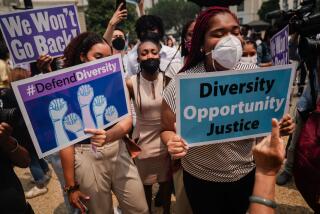Jury Out on Whether Affirmative Action Beneficiaries Face Stigma : Research: Studies arrive at conflicting conclusions. But openness by an employer or school about the selection process helps programs gain acceptance.
- Share via
One of the most divisive questions in the affirmative action debate is whether the preferences hurt the very people they were intended to help.
Some researchers have found that the stigma of being hired as part of an affirmative action effort erodes self-esteem and colors people “presumed incompetent” in the eyes of their colleagues. Others have found the opposite: that people benefiting from affirmative action feel welcomed, and appreciate the opportunity to display their abilities.
The one conclusion most social scientists agree on is that whether affirmative action helps or hurts depends on exactly how a particular program is set up. When it hurts, it seems to affect white women more than blacks.
“I keep reading about these people who feel stigmatized,” said Kerman Maddox, an African American who is president of Maddox Communication. “But I’ve yet to meet a single one. I’ve never felt any stigma at all.”
But a former UC Davis postdoctoral student who wished not to be identified is still bitter about her experience.
“I won a major prize, and some of the guys in my lab said it was because I was a woman. I’m certain they didn’t choose me because I was a woman. But it gave some disgruntled guys who didn’t get the prize a convenient excuse.”
In fact, the single biggest problem with affirmative action programs, researchers agree, is that no one seems to know what selection procedures actually entail.
When people believe that an affirmative action program is designed to choose between equally qualified candidates, beneficiaries don’t suffer and colleagues are not opposed. But given no information, both recipients and others may assume that unqualified people are selected on the basis of race or gender alone.
“People have to have clear information,” said psychologist Rupert Barnes Nacoste of North Carolina State University. “And we know that they do not.”
Very few universities or businesses, Nacoste and others said, list specific criteria: how much weight is given to test scores, to being black, the child of an alumnus, to playing football, playing the flute, or hailing from Podunk.
They also fail to spell out at what level affirmative action is being applied. MacArthur Fellowship-winning chemist Jacqueline Barton at Caltech, for example, fully supports efforts to reach out to women in hiring. But when it comes to tenure, she says, it’s a big mistake to “lower the bar.”
While listing exact criteria for hiring or admissions may not be feasible for a variety of legal and ethical reasons--and few institutions even attempt to do it--researchers have concluded that moving toward openness is the only way affirmative action is going to succeed.
Studies conducted by New York University psychologist Madeline Heilman, for example, showed that when women applicants don’t know the criteria, they “fill in the blanks; they make the presumption that they are being hired on the basis of group membership, not on their credentials as a person. And once that assumption is made, it . . . (can) make you suspicious about your own abilities,” Heilman said.
Other studies, however, have failed to find any indication that beneficiaries felt stigmatized.
“There’s a lot less research than there ought to be,” said sociologist James Kleugel of the University of Illinois. “We need to be raising questions that are open-minded and not driven by ideology on either side.”
Nacoste, Heilman and others say affirmative action should be re-examined with an eye toward eliminating the kind of ambiguity that results in emotional harm--a position, says Nacoste, that often gets him “blasted from both sides.”
Heilman agrees: “When I started, (my position) was a conservative view. Now it’s middle of the road. The solution isn’t to do away with affirmative action. Discrimination is very real. But it needs to be re-examined.”
The most critical change, she suggests, is to “make it clear what is going on.”
More to Read
Sign up for Essential California
The most important California stories and recommendations in your inbox every morning.
You may occasionally receive promotional content from the Los Angeles Times.










